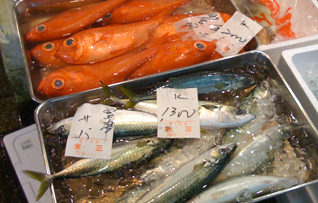 f several commercially important species in 2013 resulted in higher prices. Replacement of vessels, hatcheries and ports is on track, but further leaks of radioactive cooling water are likely. The trend of lower fish consumption continues.
f several commercially important species in 2013 resulted in higher prices. Replacement of vessels, hatcheries and ports is on track, but further leaks of radioactive cooling water are likely. The trend of lower fish consumption continues.Shortages of several species
Pacific saury that usually migrate southwest to Hokkaido instead stayed to the northeast in international waters, where they were taken by Taiwanese and other nations' vessels. This happened in 2010 and again last year, following especially hot summers. The phenomenon is increasingly frequent and appears related to global warming.
Chum salmon catches, which account for 75 percent of Japan's domestic salmon catch, were hurt by tsunami destruction of hatchery facilities. Ground water used by wells at some hatcheries was salinated when land subsided, but concrete rearing pools survived and electricity and plumbing have been restored, so that most now function normally.
Russia finally succeeded in pressuring its Pacific neighbors to help its crackdown on crab poaching. King crab flooded into Japan in the spring before final implementation of the agreement to require certificates of origin, but imports declined drastically this winter resulting in higher king and snow crab prices.
The continuing shortage of glass eels drove farmed eel prices so high that many traditional kabayaki eel shops closed. This traditional dish is disappearing, and eels are now being served as special toppings for rice bowls at chains like Yoshinoya and Sukiya instead, this dish requiring a smaller portion of eel.
Tsunami recovery on track while Fukushima problem lingers
Outside of Fukushima Prefecture, monitoring has shown occasional excessive radioactivity levels only for bottom feeding fish. However, additional leaks of radioactive water occurred in 2013, into the ocean in October and into soil in December. The need to store increasing quantities of cooling water makes further releases to the ocean likely.
In September, South Korea newly banned products from eight prefectures including and surrounding Fukushima. China, Taiwan and the United States retain some restrictions on seafood from specified areas as well. Among the major export items, yellowtail and sea bream are farmed in unaffected areas far south of Fukushima. Alaska Pollock, scallops and saury are the main export products still affected by bans or consumer rejection.
The government has reached its goal for replacing lost vessels. Rebuilding of ports is expected to be mostly completed by 2015. At the 319 affected ports, the landing function has been recovered for the total length of the landing pier at 115 fishing ports (36 percent) and for part of the length of the landing pier at 149 fishing ports (47 percent).
Miyagi oyster farming has been revived, partly by an emergency relaxation of fishing regulations to give corporations equal access to aquaculture sites with fishermen's cooperatives. The move is seen as a pilot program for further commoditization of access to inshore fishing rights.
Lower fish consumption continues
The general trend of lower fish consumption has continued. With more women in the workforce, easily prepared seafood dishes are needed. Fewer women are willing to clean or cut up fish. Children, meanwhile, dislike the difficulty of removing bones. A disturbing statistic noted in the government's most recent Fisheries White Paper is the disappearance of the "age-related effect" in which Japanese tended to eat more fish as they aged.







